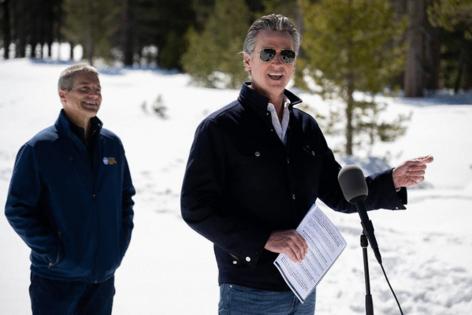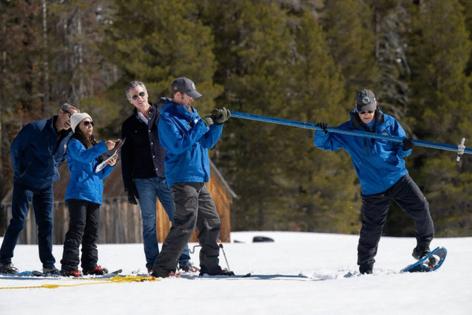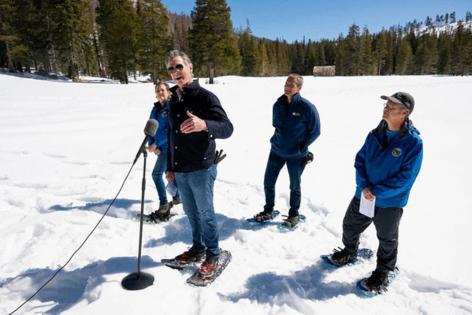Gov. Gavin Newsom surveys California snowpack, unveiling water plan for an uncertain future
Published in Weather News
Surrounded by a blanket of snow, Gov. Gavin Newsom donned snowshoes Tuesday to observe officials surveying this year’s snowpack and unveil a new California water resources plan that factors in climate realities.
The snowpack across the state was measured at a little above average — a rarity after recent swings between extreme drought and last year’s record snowpack at double the historic average.
But the governor warned Californians not to get comfortable as climate change makes the Sierra reserves less reliable. State water officials forecast that water supply from melting snow will shrink by 10% in two decades.
“There’s nothing normal about this average year,” Newsom said from Phillips Station, located along Highway 50 near Echo Summit. The Department of Water Resources held its final in-person survey of the current water year at the site.
“The hots are getting a lot hotter, the dries drier, and that requires us to have a sophistication of approach.”
The key metric of snow water equivalent was measured Tuesday at a statewide average of 28.6 inches – 110% of normal for April 1, state water officials said.
During the previous monthly snow survey, on Feb. 29, state officials measured statewide snow water equivalent at 18 inches – 80% of normal for the start of March and 70% of the April 1 average. Major storms in early March, including blizzard conditions in the Lake Tahoe area, helped boost the snow level.
“Average is awesome,” said Karla Nemeth, director of the Department of Water Resources. “But average may be becoming less and less common of a feature for snowpack in California.”
Climate change is leading to rising temperatures, scientists say, which will lead to more of the atmosphere’s water falling as rain rather than snow. Higher temperatures also lead to faster snowmelt, diminishing the snowpack.
As for this year, Nemeth said, weather patterns over the next couple of months will determine how much of today’s snow turns into water supplies this spring and summer.
“We’re in a good place right now,” said engineer Andy Reising. “We refer to the April 1 metric because it’s typically our peak snowpack, even though the climate is changing that slowly.”
Newsom’s newly released Water Plan Update 2023 is one of several water related policy strategies that he has released in recent years and framed as part of the state’s fight against climate change.
His 2022 California Water Supply Strategy focused on increasing resources for conservation strategies such as water recycling and stormwater capture, as well as infrastructure developments.
The 300-page plan plots a path to prioritize resilience against climate change, manage resources at a watershed level and underscore equity in management of the state’s water.
Those include the Sites Reservoir in Colusa County and the Delta Conveyance Project, which the state has proposed for decades to ship water from the state’s northern regions to Southern California.
California releases a new Water Plan update every five years to guide local agencies’ use and development of water resources. Newsom said it builds on his previous policy strategies.
Water Plan Update 2023, according to a Tuesday news release from the Department of Water Resources, “focuses on three intersecting themes: addressing climate urgency, strengthening watershed resilience, and achieving equity in water management.”
California is home to dozens of watersheds, which mark the area of land where water is naturally channeled as rainfall, snowmelt and runoff into the state’s rivers, bays and ultimately the Pacific Ocean.
Snowpack has historically made up around two-thirds of California’s total water supply. State scientists have surveyed snow since 1941 as a key tool to forecast future supply for farms and cities.
Several times a year, state water officials manually measure the depth and weight of snow at Phillips Station and other sites.
Water estimates began to incorporate remote electronic sensors in the 1990s, with aerial surveys launching in recent years. Early April is considered a key indicator of what’s to come.
Tuesday’s manual survey at Phillips Station showed snow water equivalent of 27.5 inches, which is 113% of average for the station this time of year.
Department of Water Resources snow sensor data on Tuesday showed the northern Sierra Nevada mountains at 124% of average, the central Sierra at 107% and the southern Sierra at 100%.
‘Not victims of fate,’ Newsom says of climate change
With a sweeping look at water management since the 1850s, the plan identified the 1950s and 60s as a period of infrastructure expansion.
The 2020-25 era? It’s marked by climate crisis and social change.
“I want people to know that we are not victims of fate,” Newsom said. “We recognize the world we’re living in. We recognize the trend lines into the future and we’re navigating them.”
California is the only western state that performs its own snow survey, said J. Pablo Ortiz-Partida, researcher for the Union of Concerned Scientists.
In a blog post, he said officials should also measure how reservoirs are increasingly misaligned with the state’s climate patterns because they’re situated where snowfall is becoming more scarce.
State water officials on Tuesday said statewide reservoir levels are now at 116% of average.
Only a “comprehensive reevaluation and redesign of California’s water infrastructure” will ensure the state is capable of meeting the demand for water amid this historical shift.
“A future with reduced snow is imminent,” he wrote. “California state and local agencies need to plan for it.”
_____
©2024 The Sacramento Bee. Visit sacbee.com. Distributed by Tribune Content Agency, LLC.












Comments